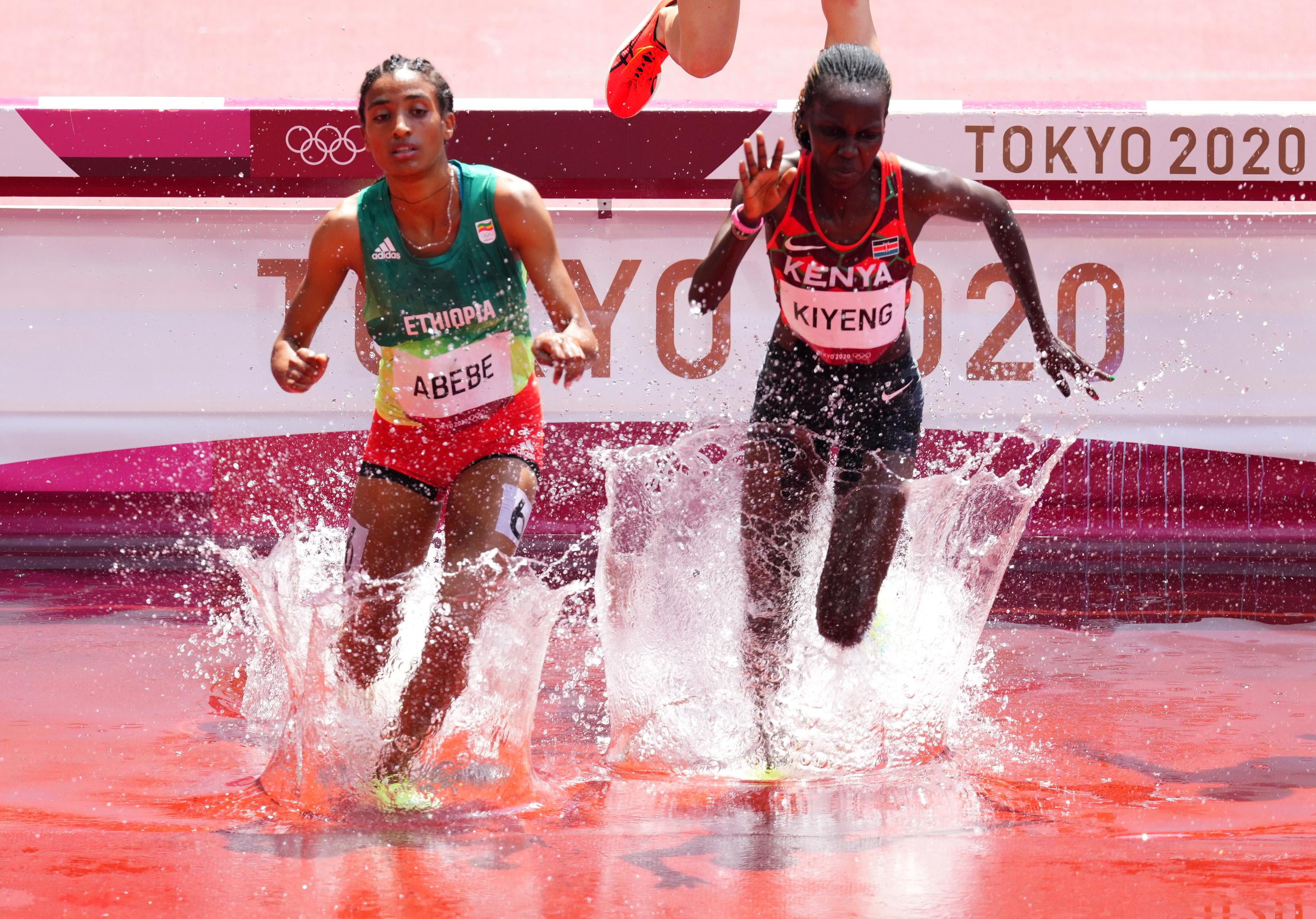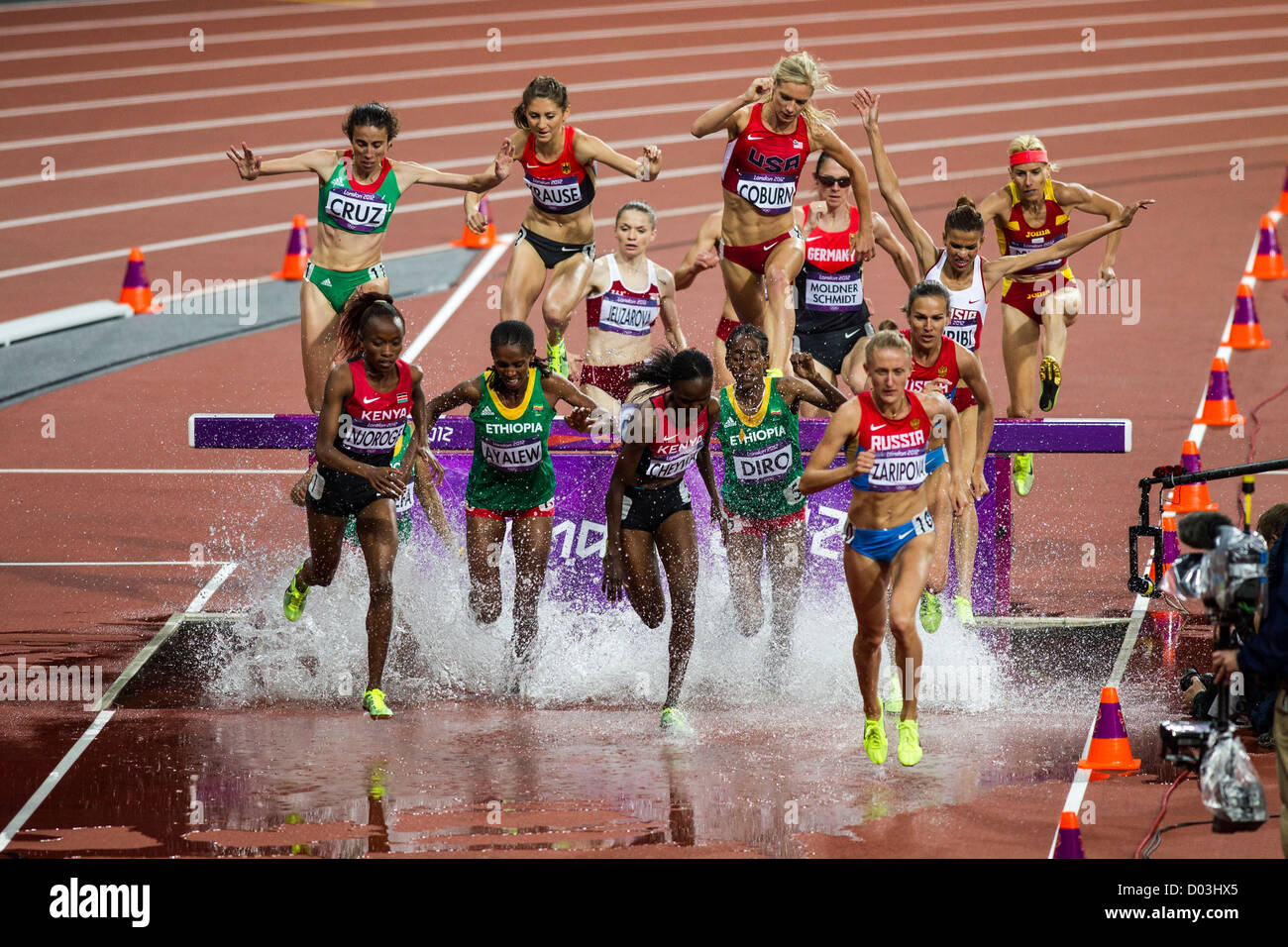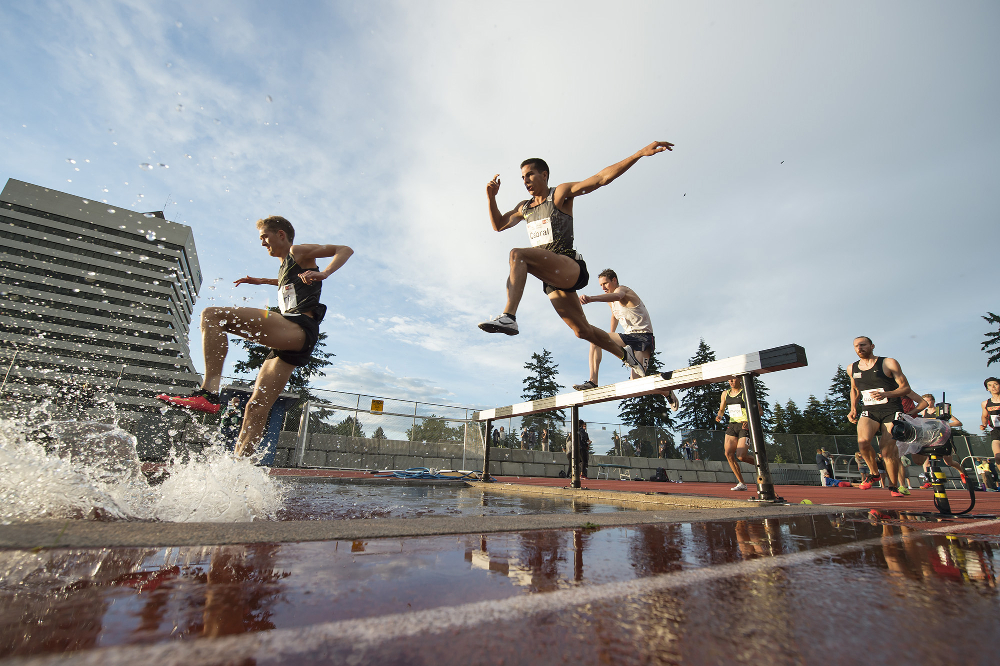History and Evolution of the 3000m Steeplechase: 3000m Steeplechase Olympics

The 3000m steeplechase is a thrilling and demanding event in track and field, where athletes navigate a course with obstacles. Its evolution from its humble beginnings to the Olympic stage is a story of innovation, athleticism, and enduring appeal.
Origins and Development of the Event
The steeplechase traces its roots back to the 19th century, inspired by cross-country races over natural obstacles. The first steeplechase race was held in 1860 at the Sandown Park racecourse in England, featuring a course with a series of hurdles and a water jump. The name “steeplechase” derives from the practice of racing towards a church steeple in the early versions of the event.
Key Rule Changes and Innovations
Throughout its history, the steeplechase has undergone significant rule changes and innovations.
* Early Races: The initial steeplechase races were characterized by a variety of obstacle types and distances, with no standardized rules.
* Standardization of Rules: In the early 20th century, the International Association of Athletics Federations (IAAF) established standardized rules for the steeplechase, including the distance (3000 meters), the number of obstacles (28), and the height of the hurdles (91.4 centimeters).
* Water Jump: The water jump, a defining feature of the steeplechase, has evolved over time. Initially, athletes were required to jump over a ditch filled with water. Later, the ditch was replaced with a pool of water, and the water jump became a more technical and challenging obstacle.
* Water Barrier: In the 1980s, the water jump was further modified to include a water barrier, which athletes must clear before entering the pool. This innovation added an element of difficulty and required athletes to adjust their technique.
Comparison with Other Obstacle Races
The 3000m steeplechase shares similarities with other obstacle races, such as cross-country running and mud runs. However, the steeplechase is unique in its focus on technical hurdles and the water jump, which require specialized skills and endurance.
Impact of Notable Athletes
The steeplechase has been graced by numerous legendary athletes who have contributed to its growth and popularity.
* C.J. Gardener: C.J. Gardener, an American athlete, dominated the steeplechase in the 1930s, winning the Olympic gold medal in 1932. His record-breaking performances helped establish the event as a major attraction.
* Kenisis Bekele: Kenisis Bekele, an Ethiopian athlete, is widely regarded as one of the greatest steeplechasers of all time. He holds the world record for the 3000m steeplechase and has won multiple Olympic medals.
* Ruth Jebet: Ruth Jebet, a Kenyan athlete, broke the world record in the women’s 3000m steeplechase in 2016, demonstrating the growing popularity and competitiveness of the event among women athletes.
The 3000m steeplechase has evolved significantly over the years, reflecting advancements in athletic training, rule changes, and the contributions of exceptional athletes. It continues to captivate audiences with its unique blend of speed, endurance, and technical skill.
Techniques and Strategies in the 3000m Steeplechase

The 3000m steeplechase is a grueling race that demands a unique blend of speed, endurance, and technical proficiency. Success in this event requires mastering specific techniques for hurdle clearance, water jump negotiation, and pacing, while also employing strategic race tactics to optimize performance.
Hurdle Clearance Techniques
Hurdle clearance is a critical element of the steeplechase, and athletes employ different techniques to maximize efficiency and minimize energy expenditure.
- Lead Leg Drive: The lead leg drives forward, propelling the athlete over the hurdle. The knee is lifted high, ensuring a clear clearance, while the foot lands in front of the hurdle, minimizing the impact and maintaining momentum.
- Trail Leg Swing: The trail leg swings through, providing additional momentum and ensuring a smooth transition over the hurdle. The athlete aims to keep the trail leg close to the body, minimizing resistance and maximizing efficiency.
- Body Posture: Maintaining an upright posture throughout the hurdle clearance is crucial. This helps the athlete maintain balance and control, preventing potential stumbles or falls. A slight lean forward can help to maintain momentum and improve efficiency.
Water Jump Negotiation
The water jump is a defining feature of the steeplechase, and athletes must develop specific techniques to navigate it effectively.
- Approach: Athletes approach the water jump with a controlled pace, ensuring they maintain a consistent rhythm. A slight increase in speed can be beneficial, providing additional momentum to clear the water.
- Foot Placement: The foot placement is crucial when entering the water. Athletes aim to land with their lead foot just in front of the edge of the water, minimizing the splash and maximizing forward momentum.
- Water Entry: Upon entry, athletes strive to keep their body low and streamlined, minimizing resistance from the water. A slight lean forward can help to maintain balance and reduce the impact of the water.
- Exit: Exiting the water jump requires a powerful push-off with the lead foot. Athletes aim to exit the water with a strong stride, minimizing the time spent in the water and maximizing forward momentum.
Pacing Strategies
Pacing is a crucial aspect of the steeplechase, and athletes employ various strategies to conserve energy and maximize performance.
- Even Pacing: This strategy involves maintaining a consistent pace throughout the race, avoiding surges or dips in speed. This approach is often used by athletes with a strong endurance base, ensuring they can sustain a high level of effort over the entire distance.
- Negative Split: This strategy involves running the first half of the race at a slightly slower pace and then increasing the speed in the second half. This approach allows athletes to conserve energy early in the race, reserving their strength for a strong finish.
- Surge and Hold: This strategy involves making a strong surge in speed at a specific point in the race, often in the latter stages. This approach can be effective for breaking away from competitors, but it requires a high level of fitness and a calculated risk.
Running Styles, 3000m steeplechase olympics
Different running styles are employed by steeplechase athletes, each with its advantages and disadvantages.
- High-Knee Style: This style involves lifting the knees high, providing a powerful drive and a smooth transition over hurdles. This style can be efficient but can be tiring over long distances.
- Long Stride Style: This style involves taking longer strides, maximizing ground coverage and minimizing the number of steps. This style can be effective for maintaining speed but can be less efficient over hurdles.
- Cadence Style: This style involves taking shorter, quicker steps, maximizing turnover and maintaining a consistent rhythm. This style can be effective for maintaining speed and endurance but may be less efficient over hurdles.
Mental Focus and Race Strategy
Mental focus and race strategy are critical for success in the steeplechase.
- Pre-Race Preparation: Athletes prepare mentally by visualizing the race, focusing on their goals, and developing a plan for executing their race strategy.
- Focus and Concentration: Maintaining focus throughout the race is essential. Athletes must be aware of their position, their competitors, and the race pace, making adjustments as needed.
- Pain Management: The steeplechase is a physically demanding race, and athletes must learn to manage pain and discomfort. Techniques such as positive self-talk and visualization can help to maintain focus and motivation.
- Strategic Decision-Making: Athletes must make strategic decisions throughout the race, adapting their approach based on the race situation and their own physical condition.
Training and Conditioning
Training and conditioning are essential for achieving peak performance in the steeplechase.
- Endurance Training: Athletes engage in extensive endurance training to develop the physical capacity to run the 3000m distance. This often involves long runs, tempo runs, and interval training.
- Strength Training: Strength training is crucial for developing the muscles needed for hurdle clearance, water jump negotiation, and maintaining speed. This often involves exercises targeting the legs, core, and upper body.
- Hurdle and Water Jump Practice: Athletes dedicate significant time to practicing hurdle clearance and water jump negotiation, refining their techniques and improving efficiency.
- Race Simulation: Athletes engage in race simulations, replicating the conditions of a real competition to prepare mentally and physically for the demands of the event.
Notable Athletes and Olympic Moments

The 3000m steeplechase has been graced by a constellation of extraordinary athletes who have etched their names in Olympic history. From record-breaking performances to unforgettable moments of grit and determination, these athletes have captivated audiences and elevated the event to new heights.
Olympic Champions and Medalists
The following table provides a comprehensive overview of the Olympic champions and medalists in the men’s and women’s 3000m steeplechase:
| Year | Event | Gold | Silver | Bronze |
|—|—|—|—|—|
| 1920 | Men’s 3000m Steeplechase | Percy Hodge (GBR) | Patrick Flynn (USA) | Earl Eby (USA) |
| 1924 | Men’s 3000m Steeplechase | Ville Ritola (FIN) | Earl Eby (USA) | James Hunter (GBR) |
| 1928 | Men’s 3000m Steeplechase | Toivo Loukola (FIN) | Eino Purje (FIN) | Volmari Iso-Hollo (FIN) |
| 1932 | Men’s 3000m Steeplechase | Thomas Evenson (USA) | John Disley (GBR) | Joe McCluskey (USA) |
| 1936 | Men’s 3000m Steeplechase | Volmari Iso-Hollo (FIN) | Alastair McCorquodale (GBR) | John Disley (GBR) |
| 1948 | Men’s 3000m Steeplechase | Tore Sjöstrand (SWE) | Erik Elmsäter (SWE) | Göte Hagström (SWE) |
| 1952 | Men’s 3000m Steeplechase | Horace Ashenfelter (USA) | John Disley (GBR) | Kurt Stenqvist (SWE) |
| 1956 | Men’s 3000m Steeplechase | Chris Brasher (GBR) | Sándor Rozsnyói (HUN) | Ernest Larsen (USA) |
| 1960 | Men’s 3000m Steeplechase | Zdzisław Krzyszkowiak (POL) | Sándor Rozsnyói (HUN) | Heinz Laufer (GER) |
| 1964 | Men’s 3000m Steeplechase | Henry Rono (KEN) | Gaston Roelants (BEL) | Wolfgang Bohne (GER) |
| 1968 | Men’s 3000m Steeplechase | Amos Biwott (KEN) | Benjamin Kogo (KEN) | Anatoly Kudryavtsev (URS) |
| 1972 | Men’s 3000m Steeplechase | Kipchoge Keino (KEN) | Ben Jipcho (KEN) | Thomas Wessinghage (FRG) |
| 1976 | Men’s 3000m Steeplechase | Anders Gärderud (SWE) | Bronisław Malinowski (POL) | Frank Baumgartl (GDR) |
| 1980 | Men’s 3000m Steeplechase | Bronisław Malinowski (POL) | Patriz Ilg (GDR) | Bogdan Kocewicz (POL) |
| 1984 | Men’s 3000m Steeplechase | Julius Korir (KEN) | Joseph Chesire (KEN) | Henry Marsh (USA) |
| 1988 | Men’s 3000m Steeplechase | Julius Kariuki (KEN) | Hagen Melzer (GDR) | Azzedine Brahmi (ALG) |
| 1992 | Men’s 3000m Steeplechase | Matthew Birir (KEN) | William Mutwol (KEN) | Simon Vroemen (NED) |
| 1996 | Men’s 3000m Steeplechase | Joseph Keter (KEN) | Alessandro Lambruschini (ITA) | Wilson Boit Kipketer (KEN) |
| 2000 | Men’s 3000m Steeplechase | Saif Saaeed Shaheen (QAT) | Ali Ezzine (MAR) | Brahim Boulami (MAR) |
| 2004 | Men’s 3000m Steeplechase | Ezekiel Kemboi (KEN) | Brimin Kipruto (KEN) | Paul Kipsiele Koech (KEN) |
| 2008 | Men’s 3000m Steeplechase | Brimin Kipruto (KEN) | Ezekiel Kemboi (KEN) | Richard Mateelong (KEN) |
| 2012 | Men’s 3000m Steeplechase | Ezekiel Kemboi (KEN) | Conseslus Kipruto (KEN) | Mahiedine Mekhissi-Benabbad (FRA) |
| 2016 | Men’s 3000m Steeplechase | Conseslus Kipruto (KEN) | Evan Jager (USA) | Mahiedine Mekhissi-Benabbad (FRA) |
| 2020 | Men’s 3000m Steeplechase | Soufiane El Bakkali (MOR) | Lamecha Girma (ETH) | Benjamin Kigen (KEN) |
| 1988 | Women’s 3000m Steeplechase | Ulrike Klapezynski (GDR) | Cristina Cojocaru (ROU) | Maria Avilés (ESP) |
| 1992 | Women’s 3000m Steeplechase | Marina Tkachuk (EUN) | Lynn Williams (USA) | Anita Weyermann (SUI) |
| 1996 | Women’s 3000m Steeplechase | Svetlana Osmolovskaia (RUS) | Dorcus Inzikuru (UGA) | Anzhela Mudra (UKR) |
| 2000 | Women’s 3000m Steeplechase | Gülcan Mıngır (TUR) | Cristina Casandra (ROU) | Patricia Miranda (POR) |
| 2004 | Women’s 3000m Steeplechase | Gulnara Samitova (RUS) | Ekaterina Ivolgina (RUS) | Tatyana Petrova (RUS) |
| 2008 | Women’s 3000m Steeplechase | Gulnara Samitova (RUS) | Eunice Jepkorir (KEN) | Tatyana Petrova (RUS) |
| 2012 | Women’s 3000m Steeplechase | Julia Zaripova (RUS) | Habiba Ghribi (TUN) | Sofia Assefa (ETH) |
| 2016 | Women’s 3000m Steeplechase | Ruth Jebet (BAR) | Hyvin Kiyeng (KEN) | Emma Coburn (USA) |
| 2020 | Women’s 3000m Steeplechase | Peruth Chemutai (UGA) | Courtney Frerichs (USA) | Hyvin Kiyeng (KEN) |
Iconic Moments and Memorable Performances
The Olympic stage has witnessed a multitude of iconic moments and memorable performances in the 3000m steeplechase.
* The Rise of Kenyan Dominance: Kenyan athletes have established an unparalleled dominance in the men’s 3000m steeplechase, claiming 15 of the 21 gold medals since the event’s inception. Their exceptional endurance, tactical prowess, and water jump technique have made them formidable competitors.
* The World Record of Saif Saaeed Shaheen: In 2004, Saif Saaeed Shaheen, then representing Qatar, shattered the world record with a time of 7:53.63, a feat that stood for nearly a decade. This performance highlighted his extraordinary talent and cemented his place among the all-time greats.
* The Dramatic Finish of the 2008 Olympics: The 2008 Beijing Olympics witnessed a thrilling finish in the men’s 3000m steeplechase, with Brimin Kipruto of Kenya edging out Ezekiel Kemboi, his teammate, in a photo finish. This intense rivalry showcased the depth of talent within Kenyan steeplechase.
* The Historic Victory of Ruth Jebet: In the 2016 Rio Olympics, Ruth Jebet, representing Bahrain, became the first woman to break the 9-minute barrier in the 3000m steeplechase, setting a new world record of 8:59.75. This landmark achievement propelled her to Olympic glory and established her as a force to be reckoned with.
Competitive Landscape and Evolving Records
The competitive landscape in the 3000m steeplechase has evolved significantly over the years, with new athletes emerging to challenge the established order. The event has witnessed a steady progression in world records, reflecting the increasing level of athleticism and training methodologies.
* The Rise of Ethiopia and Morocco: In recent years, athletes from Ethiopia and Morocco have emerged as formidable contenders, pushing the boundaries of the event. Lamecha Girma of Ethiopia, with his remarkable speed and agility, has become a force to be reckoned with, while Soufiane El Bakkali of Morocco, known for his tactical brilliance, has consistently challenged the Kenyan dominance.
* The Women’s Steeplechase: A Growing Force: The women’s 3000m steeplechase has witnessed a surge in popularity and competitiveness, with athletes from diverse backgrounds breaking records and challenging the established order. The event has become a platform for showcasing the athletic prowess of women, highlighting their endurance and determination.
Impact of Individual Athletes
Individual athletes have played a pivotal role in shaping the 3000m steeplechase, inspiring generations of athletes and captivating audiences worldwide. Their accomplishments have not only raised the profile of the event but also contributed to the global appeal of athletics.
* The Legacy of Ezekiel Kemboi: Ezekiel Kemboi of Kenya, a four-time Olympic medalist, is widely regarded as one of the greatest steeplechasers of all time. His exceptional water jump technique, tactical brilliance, and flamboyant celebrations have made him an icon of the sport.
* The Inspiration of Gulnara Samitova: Gulnara Samitova of Russia, a two-time Olympic champion, is renowned for her exceptional endurance and her ability to overcome adversity. Her world record-breaking performance in the 2008 Olympics inspired countless athletes and cemented her place among the legends of the steeplechase.
3000m steeplechase olympics – The 3000m steeplechase is a grueling race, testing the endurance and agility of athletes as they navigate water jumps and hurdles. After the race, a well-deserved rest is essential, and what better way to unwind than in a comfortable rooms to go leather chair and ottoman ?
Imagine sinking into the plush leather, reflecting on the adrenaline rush of the race, and letting the soothing comfort wash over you. The 3000m steeplechase demands the utmost physical and mental strength, and a relaxing moment in a luxurious chair can help athletes recover and prepare for their next challenge.
The 3000m steeplechase at the Olympics is a grueling test of endurance and strategy, demanding both raw power and tactical finesse. Imagine the athletes, after crossing the finish line, sinking into a plush american leather swing chair to relax and recover, their muscles aching but their spirits soaring with the thrill of competition.
Just as the steeplechase demands a perfect blend of strength and agility, a comfortable swing chair offers the perfect balance of support and gentle movement, providing a sanctuary of peace after the storm of the race.